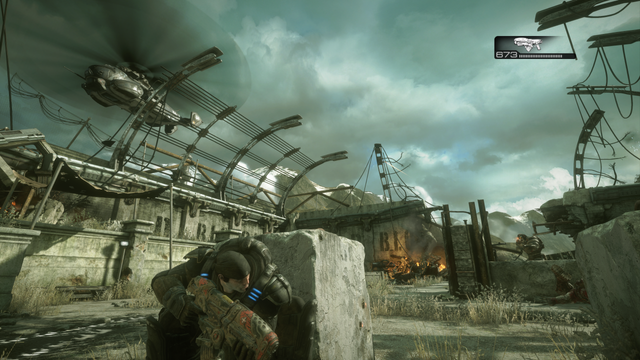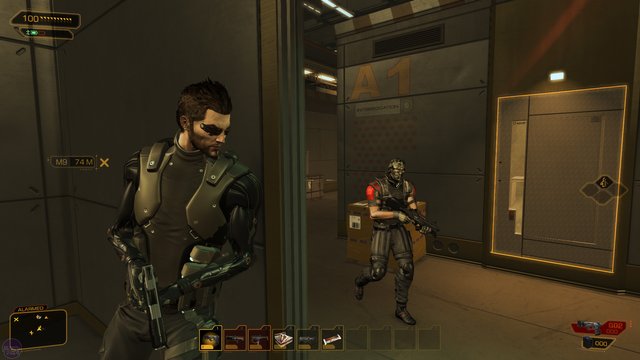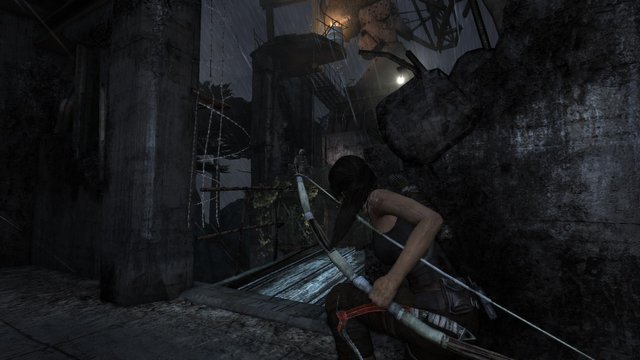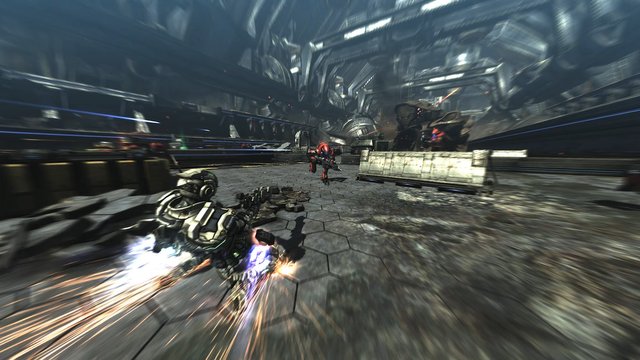The Rise of Cover-Based Shooting

Well, hello there! Today I'm going to ramble about cover systems in shooters, both first person and third person.
The idea of hiding behind something to avoid enemy fire is only natural, because who would like to become a storage container for the enemies' used bullets? Anyway, let us look at the history of the mechanic, mainly to see its evolution and usage along all these years. The earliest example of cover in a video game comes from Taito's 1975 arcade machine Gun Fight/Western Gun, depending on where you encountered it at the time. Funnily enough, this is also an early example of competitive cover-based shooting, the machine pitting two players against each other in a, you guessed it, western duel, with 6 bullets each and cover such as cacti and stagecoaches. The cover mechanic would return later in 1978 in Taito's Space Invaders, which is so rooted in popular culture now that it is synonymous with the term of video game.

In 1988, Konami released Devastators, which featured a pseudo-3D world, similar to those '3D' levels in Contra, with the catch that now the game world had clutter, in absence of a better term, to shield yourself from enemy fire. In 1995, Blizzard Entertainment (yes, the Diablo, Starcraft and Word of Warcraft guys) released Blackthorne, a cinematic platformer in which you could stick to walls to avoid enemy fire. Sounds pretty modern, right? Now, we need to go back to the arcades, to games like Time Crisis from Namco, which had you press a pedal on the machine to take cover, which is quite ingenious for a light gun shooter (oh, how I miss those). In PC first person games we had System Shock with its lean function, which let you pop out from behind a wall and take shots at the atrocities on the Citadel Station. Sounds awfully forward thinking, like most Looking Glass titles, so it fits in just nice. They, again, came up with a new innovation, by using the lean mechanic in Thief: The Dark Project, but for stealth instead of combat. Of course, we can not forget Deus Ex, which is drenched in Looking Glass design, even though it came from Ion Storm.
So, the modern cover systems are in place, we just need the newer games. In 1999, Koei came up with the bright idea of not letting the player fire like Rambo, from the middle of a field (which is a damn stupid restriction), effectively forcing you to give that wall a nice hug. Then, in 2000, one of my other favorite studios, Raven Software, realeased Soldier of Fortune, which brought back the concept of the lean mechanic previously seen in the Looking Glass designs, and also brought it to multiplayer.
And here pops up Gears of War to claim all the merits for this ever-evolving game mechanic, ignoring all the history it went through. The rise of the chest high walls in video games. From now on, if your game is a third person shooter, it has the gears of war cover system. Or not? I will come back to that idea a bit later.

Now, we are going to speak about cover in contemporary first person games. Killzone 2 (arguably the best game in the series) Introduced a snap to cover, a la Gears of War (oh, for crying out loud, that game pops up everywhere in this discussion), with the catch that you remain at all times in first person. Other first person games opted for a more interesting switch of perspective when entering cover, like the new Deus Ex games, the Rainbow Six: Vegas series and the first person mode for Grand Theft Auto V.

A more interesting approach to this mechanic is contextual cover, present in the rebooted Tomb Raider series, The Last of Us and Quantum Break, which makes the player character crouch down when near an object that can shield you from bullets. I genuinely prefer this approach, because it does not force me to snap to cover, letting me flee much easier in the case of a compromised flank or a stray grenade near me. There is also first person contextual cover, which I have first seen in Far Cry 3, in the E3 demo, and it genuinely blew my mind at the time. This kind of cover also, conversely, exists in Destiny, which is weird to be honest, and also in Fallout 4, implemented in a janky Bethesda way, meaning that sometimes it works and sometimes it does not for no apparent reason. Let's not forget about that lean mechanic, which is present in the Machine Games Wolfenstein series and in Dishonored and Prey from Arkane Studios, so that is still nice.

But what if you use the cover to get a breather from the action instead of treating it as a part of yourself? Oh! You mean Vanquish. That game broke third person shooters for me. You rocket slide along the arenas, have a bullet time ability, which uses the same energy pool as the rocket slide, but they can be used at the same time. The cover is there to try and give the enemies a chance of survival and to also give you a breather of a few seconds to reload and charge up your suit. Neat, right? Too bad the game is too short and there is no multiplayer to keep it alive, because the concept is more than solid. It is a masterpiece.
Anyway, that would be it for this look at cover systems in video games, which is a much older mechanic than most people think, but I still blame the Gears of War series for making the boring way of using it the norm. As seen above, you can blend it with enough innovation to create something new and interesting.
-Sources: the cover image comes from cgmagonline.com, the Blackthorne image comes from retrogamingaus.com, the Deus Ex: Human Revolution image comes from bit-tech.net, the Tomb Raider reboot image comes from notebookcheck.net, the Vanquish image comes from jocuri.go4it.ro
great post
Thank you very much!
Congratulations @vladalexan, this post is the most rewarded post (based on pending payouts) in the last 12 hours written by a Dust account holder (accounts that hold between 0 and 0.01 Mega Vests). The total number of posts by Dust account holders during this period was 12489 and the total pending payments to posts in this category was $4198.55. To see the full list of highest paid posts across all accounts categories, click here.
If you do not wish to receive these messages in future, please reply stop to this comment.
The first photo seems so real, it's my favorite ;)
I remember one of the first 3D games I saw that had cover based shooting. It was Franck Herbert's Dune and it was awful :D.
I should really try and see about remaking that show one day.
Sincerely forgot about that game. Maybe it is for the best.
Also, please remake it in english :)
Heh, I remember Soldier of Fortune! I never used the Lean left\right, I had the habit of just going around and shoot like crazy. The philosophy behind shooters was different back then.
Nice article! I had no idea the concept of cover in games was that old. Anyway, I love how they developed the cover system in games like Mass Effect, even if it kinda force the developers to create most objects in the game of the same height, thus making the setting a little repetitive. I don't really like when they switch to third person from first person, especially in pure FPS, because it gives you an unfair advantage (seeing what your character can't effectively see, witch is the opposite concept of a First Person Shooter).
Never thought of that system that way. You do have a point though, it does give you an advantage, but, at least in Deus Ex, it is hardly jarring, because you also have 'player vision' aka you can see enemeies through walls, but also the fact that many interactions make you switch to third person, like climbing ladders, speaking with NPCs and enemy melee takedowns. Then again, I can see that it does not have that much of a seamless integration in the Rainbow games, giving an unfair tactical advantage in the game.
Yeah, Deus Ex is awesome as it is :D But as far as I'm concerned it might as well have been a third person game, the core qualities of Deus Ex reside in other things in my opinion :D